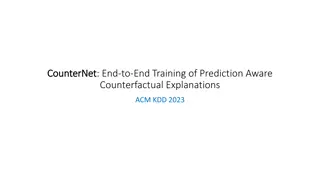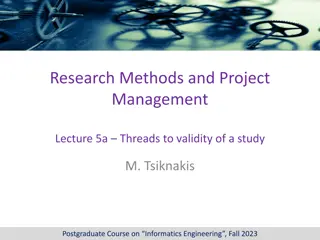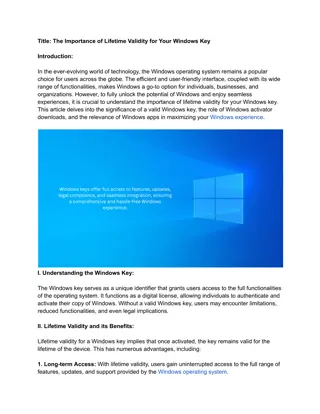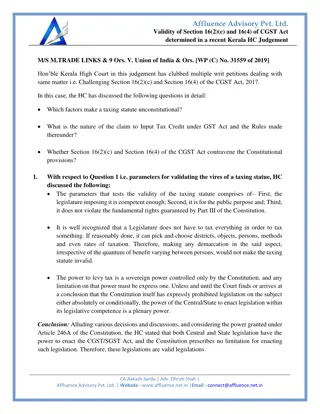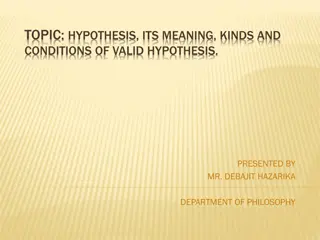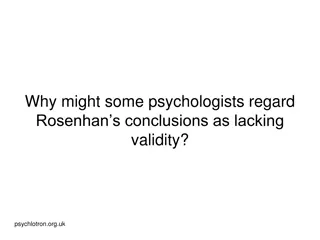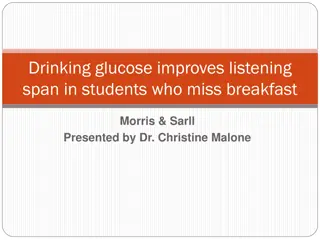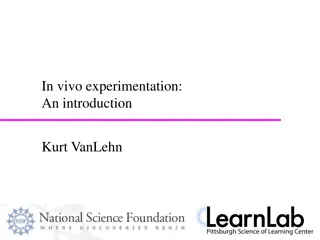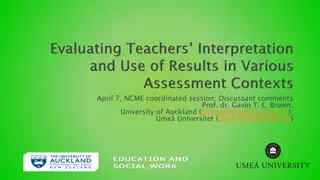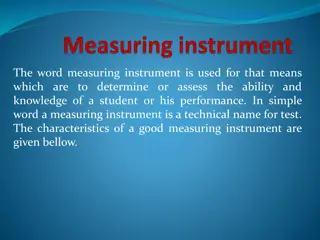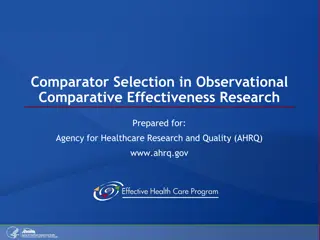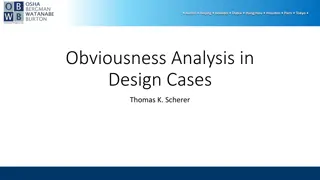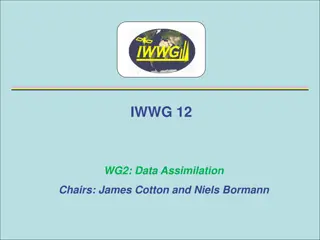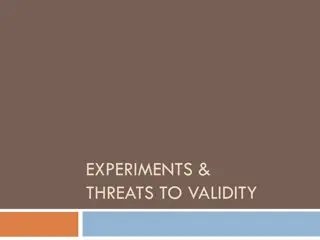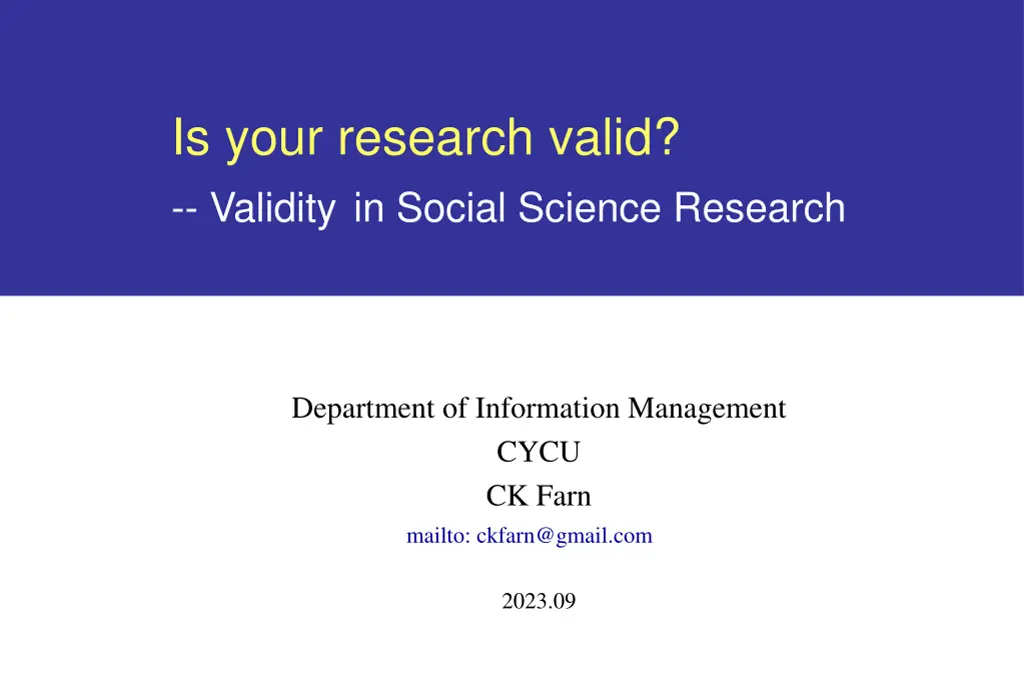
Understanding Validity in Social Science Research
Explore the concept of validity in social science research, including discussions on dependent and independent variables, construct vs. variable, proposition vs. hypothesis, and statistical conclusion validity. Delve into the importance of operationalization and different levels of validity in research design.
Download Presentation

Please find below an Image/Link to download the presentation.
The content on the website is provided AS IS for your information and personal use only. It may not be sold, licensed, or shared on other websites without obtaining consent from the author. If you encounter any issues during the download, it is possible that the publisher has removed the file from their server.
You are allowed to download the files provided on this website for personal or commercial use, subject to the condition that they are used lawfully. All files are the property of their respective owners.
The content on the website is provided AS IS for your information and personal use only. It may not be sold, licensed, or shared on other websites without obtaining consent from the author.
E N D
Presentation Transcript
Is your research valid? -- Validity in Social Science Research Department of Information Management CYCU CK Farn mailto: ckfarn@gmail.com 2023.09
Explaining the dependent variable Y Variable Acharacteristics that can take on different values The independent variable, x, is the cause The dependent variable, y, is the effect Dependent variable The focus in a research We want to explain why it changes Because of changes in some manipulated or non manipulated independent variable? Can we measure it? Different academic disciplines have different mainstream Y s x y CK Farn, CYCU 2
Validity in Social Science Research Alternate effects Conceptual Level X Y External Validity Construct Validity Construct Validity Operationalization Operationalization Internal Validity y x Causal relationship Manipulation, Observation Association Measurement Statistical Conclusion Validity error error Operational Level Cook & Campbell (1979) Quasi-Experimentation, Houghton Miffin, Boston
Construct and variable Variable A manifest and measurable characteristics that can take on different values, such as height, age, temperature, or test scores Construct An abstraction that researchers use to represent a phenomenon that s not directly observable Examples: self-esteem, motivation, job satisfaction, personal traints, and physical fitness A research construct differs from a research variable in that it is not directly measurable Construct: X, Y at conceptual level (body size) Variable: x, y at the operational level (height, weight, size of shoe ) CK Farn, CYCU 4
Proposition and Hypothesis Proposition Conceptual level, law/theory e.g. hardworking kids performs better Hypothesis Not assumption Operational level, derived from conceptual level e.g. kids spent more time studying performs better in final exams CK Farn, CYCU 5
Statistical Conclusion Validity Can we make statistical conclusion? Q: Are the dependent variable (y) and the independent variables (x) associated? co-varies? The research design should be sensitive enough to support the association among the variables If it is sensitive enough, are there evidence to support the co-variation among y and x s If there are support, what is the statistical power CK Farn, CYCU 6
A review of basic concepts in statistics Population The whole set of target Real parameters like Mean ( ) Sample A selected group of subjects from the population Estimated parameters like Average (x bar) Concepts There are some characteristics in the population that we want to know, but cannot achieve We make use of the characteristics of the samples to estimate the true population parameters Are the estimates correct? What is the chance of a correct estimate? CK Farn, CYCU 7
Issues on Statistical Conclusion Validity Statistical power Analytical methods, sample size, sampling methods Statistical significance Sample size: an important factor affecting power In the cases where the population is much higher Minimum sample size: n n = Z2p(1-p)/e2 level of significance Z: the normal Z-score at a specific level of (when =.05, Z=1.96) e: allowable error p: probability of an event (0.5 being the conservative value) CK Farn, CYCU 8
Statistical errors Type I and type II errors A type I error (false-positive ) occurs if an investigator rejects a null hypothesis that is actually true in the population A type II error (false-negative ) occurs if the investigator fails to reject a null hypothesis that is actually false in the population CK Farn, CYCU 9
Statistical errors 2 3 CK Farn, CYCU 10
Statistical errors 3 CK Farn, CYCU 11
Concept of Confirmatory Study Rule of Refutation in Empirical research Statistical inferencing can only be used to refute an aspect of theory Cannot be used to confirm a theory Process Establish theory or proposition at the logical level Establish research hypothesis at the operational level Set up alternative null hypothesis Refute the null hypothesis through statistical inferencing, accept the research hypothesis CK Farn, CYCU 12
Threats to Statistical Conclusion Validity Lack of statistical power Sample size, confidence level Violate basic assumptions of statistics Population distribution, homogeneity , independence among the x s Fishing with the research dataset CK Farn, CYCU 13
Assumptions of statistics Homogeneity Normal distribution CK Farn, CYCU 14
Threats to Statistical Conclusion Validity 2 Reliability of measurements Reliability of manipulation Random biases in research settings Internal and external uncontrollable factors Extraneous factors related to internal validity Systematic biases from informants CK Farn, CYCU 15
Internal Validity Q: If A and B co-varies, what are the possible causal relationships? A A->B A??B Alternate B Causal explanation A->C->B B->A C A - A - + A + - + Extraneous influences B B B C C C + + - Eliminate possible alternative causal relationships CK Farn, CYCU 16
Threats to Internal Validity Historical events The effects of events between pretest and post test Maturity The subjects may mature during the research Changes in measurement tools Inconsistent operationalization Regression effects The subject that gets a lowest score will improve CK Farn, CYCU 17
Threats to Internal Validity 2 Selection, self selection In the case of grouping, selection will introduce bias Mortality, attrition of subjects Especially in longitudinal research Interactions among the previous factors Confusing causal explanation CK Farn, CYCU 18
Construct Validity Operationalization: Mapping from the conceptual level to the operational level manipulation and measurement Ensure that the operationalization of constructs is sound The independent variable does reflect the related constructs The independent variable does not change with the related but different variable The dependent variable should reflect the related constructs The dependent variable should not be affected by the irrelevant variable Different measures for the same constructs should converge The measurement results for related but different constructs should diverge CK Farn, CYCU 19
Threats to Construct Validity Confusions before operationalization Definition, operational definition, real-world meaning Mono-operations bias Multi-level operations For example, the concept of HOT and COLD What are the meanings of 0, 4 and 36.5 Celcius? Mono-method bias Can we measure the weight of an individual to determine whether one is a BIG GUY? Need to use multiple measures Speculations on the research proposition by informants CK Farn, CYCU 20
Threats to Construct Validity2 Informant apprehension to the measurement process Specific expectation by the informants on the results Confusions on the constructs, and its levels Interactions among the operations, manipulations and measurements CK Farn, CYCU 21
Measurement Model Some constructs are manipulated, some are measured Different types of construct validity Face validity Each and every measure Content Validity The entire set of measures Criterion Validity Relationships with the real-world empirical validity, concurrent validity, predictive validity Convergent/divergent Validity Relationships among items Construct Manifest variables, Measurement items CK Farn, CYCU 22
Reliability The stability and robustness of a measurement tool Internal consistency among the measurement items Internal consistency among the raters Rating gymnastic competitions in Olympic games CK Farn, CYCU 23
Construct validity and reliability CK Farn, CYCU 24
External Validity Q: Can the research results be applied to the entire population? Which population? Target population The set of sample as formally defined The population mapped to the achieved samples Generalizability Can the research results be extended to cover other population? CK Farn, CYCU 25
External Validity Planned sample Target population Formally defined Achieved population Achieved sample CK Farn, CYCU 26
Threats to External Validity The effects of research setting Research within an organization Can you actually conduct a fully random sampling? Research in a classroom Students are different from decision makers Interactions between manipulation and selection Self selection may exclude certain samples Testing of new drugs, the volunteers may have higher will to live Interactions between research settings and manipulation Interactions between historical events and manipulation Especially in longitudinal studies Mortality, attrition, CK Farn, CYCU 27
Improve external validity through better sampling Comprehensive (Full scale) random sampling Good representativeness, high statistical power Expensive Not possible if conduction lab experiments Stratified random sampling Achieving heterogeneity Include every sub-class Selection of typical cases Week in power CK Farn, CYCU 28
Improve external validity through repetitive research Different types of repetition Concurrent repetition, continuous repetition Same researcher, different researchers Real repletion, assumed repetition (large scale research) Good repetitions in research Multiple small scale research Multiple settings Multiple researchers CK Farn, CYCU 29
Trade-offs among validities Academic research Internal > Construct > Statistical Conclusion > External Practical research, applied research Internal > External > Construct (of the Y) > Statistical Conclusion > Construct (of the X) The researchers should make conscious trade-offs among different types of validities For example, should I use students as informants (low cost, high feasibility, high internal validity, low external validity); or use real employees (high cost, low feasibility, low internal validity, high external validity) CK Farn, CYCU 30

